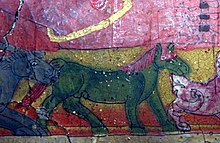Tibetan Buddhist wall paintings
Tibetan Buddhist murals in Tibet , Ladakh , Nepal and Himachal Pradesh common for Tibetan Buddhist characteristic temples and other religious places murals . They can be traced back to Kashmiri wall paintings since the 11th century.
history
Tibet had its first contact with Buddhism in the 7th century, and after an interruption again from the 10th century. To enrich Tibetan Buddhism, King Yeshe Ö sent the young monk Rinchen Sangpo , who not only returned with an extensive collection of writings, but also with 32 Kashmiri artists.
The influence of the Kashmiri style can be demonstrated in Tibetan and Ladakhi wall paintings in monasteries since the 11th century. With the Islamization of Kashmir, this art was lost there, but wall paintings from this era from Ladakh, Nepal and Himachal Pradesh are clearly part of its tradition. From the 12th century onwards, Tibet itself had become the center of Buddhism and its culture, often referred to as Lamaism today.
Content
The motifs of the wall paintings are historical figures such as the Buddhist founding figures Padmasambhava and Tsongkapa , but also gods and goddesses of the esoteric pantheon, mystics, images of lamas , scenes from the life of the historical Buddha and his previous lives. Mandalas that serve as meditation aids are of great importance. At the end of the 12th century the iconography changed and “ wrathful deities ” and yab-yum figures appeared.
technology

The wall paintings are created in the manner of Secco painting, i.e. on a dry surface. The substrate is usually a multi-layered clay plaster , the top layer of which is made as smooth as possible. This is completed by a further smoothing, usually white primer . Kaolin , chalk or plaster of paris are usually used as the material for the primer , but other white, permanent minerals can also be used.
For an initial outline of the work, preliminary studies are then carried out. This usually included geometrical structuring , and compasses were used to align mandalas . Figures were roughly sketched and then their contours, usually with black paint, made more precise. Repetitive designs are occasionally created through the use of stencils .
Traditionally, color codes were used to speed up and simplify the coloring of the various ornaments and figures. For this purpose, each section was given a number from 1 to 9 or an abbreviation for the color name. The actual painting was done either by applying a semi-liquid paste or by using a stamp made from a previously made matrix and then applied to the prepared wall.
Depending on the final visible color of a painting, special colors were used for the underpainting. For example, ocher tones were given an underpainting of light yellow. Similar to Tibetan paintings, the painting was given shading techniques, either al secco or al fresco . The shading could be done through glazes or by means of an al secco process such as shading through tiny dots of color that were applied to the surface of the painting.
Some of the wall paintings were decorated with pastiglia , a kind of relief technique . Details were achieved with small brushes using a variety of colors: black, white, ocher or red. Fine ornaments were made with gold and applied either by applying gold leaf or by mixing a powder with a binder .
proof
- ↑ a b c Alexandra Skedzuhn: Tibetan Buddhist wall paintings on clay plaster: Basics and considerations on painting technique . Bachelor thesis, 2010, abstract
- ^ OP Agrawal (ed.): Wall Paintings - Asian Perspective . In: Wall Paintings of India - A Historical Perspective. , Lucknow, p. 1, 1989
- ↑ a b c S. Bogin: A Technical Study of the Early Buddhist Wall Paintings at Nako, Himachal Pradesh, India . In: Art Technology and Conservation , 19/2, pp. 207–220, 2005
- ↑ a b c DP Jackson, JA Jackson: Tibetan Thangka Painting. Methods and Materials. Hong Kong 2006, pp. 93-111
- ^ E. Lo Bue: Tibetan painting. In: Tibet. Monasteries open their treasuries. , Exhibition catalog, Museum of Asian Art, State Museums in Berlin, Kulturstiftung Ruhr, Essen, p. 91, 2006
- ^ KL Dasser: Some Observations on the Technology of the Wall Paintings in the Sumtsek. In: Alchi. Ladakh's Hidden Buddhist Sanctuary. The Sumtsek . London, pp. 273-276, 1996
- ↑ R. Mazzeo et al .: Characterization of the wall painting dyes from the Thubchen Lakhang Temple in Lo Manthang, Nepal . In: Journal of Raman Spectroscopy 35, pp. 678-685, 2004
